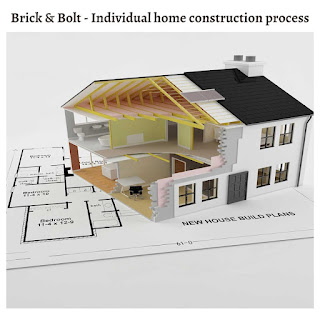Maximizing Wall Space with Brick & Bolt: Creative Construction Tips to Add Functionality

In today’s evolving real estate landscape, maximizing space has become a top priority for homeowners and architects alike. As urban homes become more compact, the importance of utilizing wall space effectively has grown significantly. Walls are no longer passive structural elements; they are opportunities for smart storage, organization, and design innovation.
If you’re planning a new home or looking to renovate an existing one, partnering with a trusted construction expert like Brick & Bolt can help you incorporate smart construction tips to optimize wall usage and drastically improve functionality without compromising on aesthetics. In this blog, we’ll explore creative ways to turn walls into functional elements through modern construction techniques.
1. Built-In Wall Niches: Functional and Aesthetic
Wall niches offer a clean and seamless alternative to bulky shelves or standalone storage units. These recessed spaces, built directly into the wall during construction, are both practical and visually appealing. In bathrooms, niches can hold toiletries, keeping surfaces clutter-free. In living rooms or entryways, they can showcase artwork, books, or collectables without taking up additional floor space.
Proper planning at the construction stage allows for the integration of lighting, tile finishes, and customized sizes to suit different rooms. By adding depth and dimension, wall niches elevate the look of interiors while serving a functional role.
2. Load-Bearing Walls with Smart Storage Integration
Traditionally, load-bearing walls are designed solely for structural support, but with a modern approach, they can serve dual purposes. By slightly increasing the thickness of select walls, builders can incorporate smart storage solutions such as narrow pull-out cabinets, concealed drawers, or shelving units within the wall cavity.
These embedded storage zones are ideal for corridors, kitchens, or bedrooms where space optimization is key. Not only does this technique maintain the structural integrity of the wall, but it also adds immense value by transforming dead space into usable storage.
3. Vertical Space Optimization in Kitchens
Kitchens often experience high traffic and limited working surfaces, making vertical space utilization essential. Instead of relying solely on countertops and lower cabinets, walls can be built to support overhead storage, hanging rails, and magnetic panels. Consider installing pegboards or slat walls that allow flexible placement of utensils, pans, and spice racks.
During construction, reinforcing kitchen walls ensures that they can bear the load of these attachments. Vertical zoning also improves workflow by keeping essential items within reach and freeing up the working area, making the kitchen more efficient and ergonomic.
4. Under-Stair and Staircase Wall Design
The areas adjacent to staircases are frequently underutilized or overlooked in many homes. However, with thoughtful design, these walls can be transformed into stylish and practical spaces. Built-in shelves, reading nooks, and decorative recesses can be incorporated into the wall design, especially if planned at the construction stage.
For duplex homes or villas, staircase walls offer vertical continuity, which can be enhanced with lighting strips, wall art niches, or hidden cabinets. These small changes add visual interest and create a cohesive flow in multi-level homes.
5. Partition Walls with Multi-Functional Features
Partition walls are an excellent way to separate spaces without enclosing them entirely. Instead of plain drywall partitions, consider constructing feature walls that integrate fold-out furniture, bookshelves, or sliding doors. A well-designed partition can serve as a TV unit on one side and a work desk on the other, depending on room orientation.
This is particularly beneficial in open-plan layouts, where space must be flexible. During construction, using materials like plywood backing or hollow-core panels enables easy retrofitting of storage, lighting, or tech devices.
6. Headboard and Bedroom Walls as Storage Units
Bedrooms typically require ample storage, but too many bulky units can make the space feel cramped. Instead, bedroom walls, particularly those behind the bed, can be designed to serve multiple purposes. Custom-built headboard walls with niches, drawers, or indirect lighting can offer both convenience and a sense of luxury.
Wardrobe walls can also be recessed into the wall cavity for a seamless look. This approach helps preserve valuable floor space and adds a refined touch to the room’s design.
7. Acoustic and Functional Wall Layers
In multi-family apartments or urban homes, noise control is often a concern. Acoustic wall panels can be constructed not only to reduce sound transmission but also to serve secondary functions. Fabric-covered panels can double as pinboards or organizers in home offices or kids’ rooms.
Similarly, double-layered walls can conceal HVAC ducts, lighting systems, or vertical gardens, turning technical necessities into design features. These systems should be integrated during the construction phase for seamless and safe implementation.
Conclusion: Walls that Do More Than Divide
In today’s compact and dynamic homes, every inch counts and walls can do much more than separate rooms. With intelligent construction planning, walls can be transformed into highly functional, aesthetically pleasing elements that add storage, increase efficiency, and enhance the living experience.
If you’re planning your next residential or commercial construction project, Brick And Bolt offers expert guidance and end-to-end solutions tailored to your needs. From design consultation to execution, we ensure every wall is built to serve, support, and simplify your lifestyle.


Comments
Post a Comment